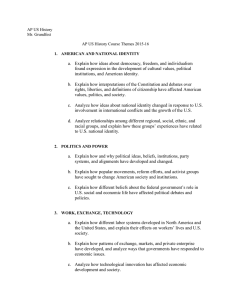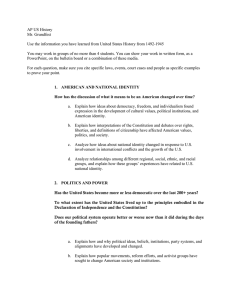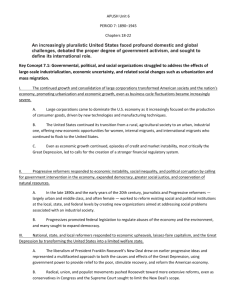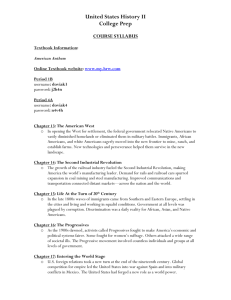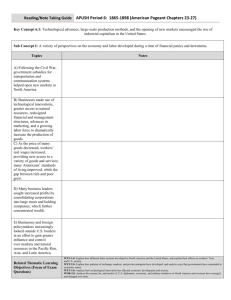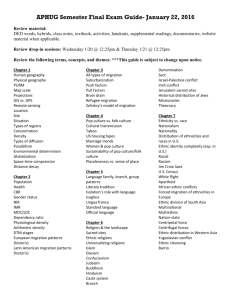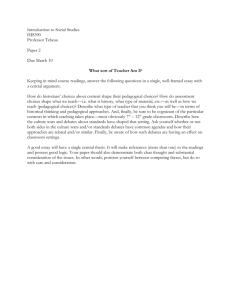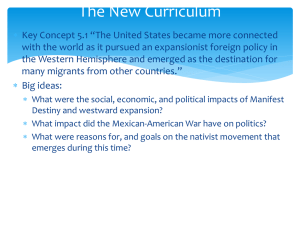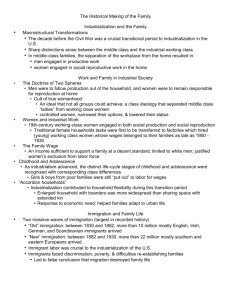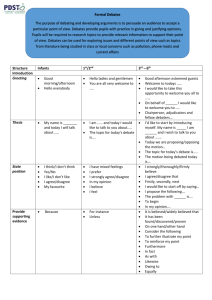APUSH KEY CONCEPTS
advertisement
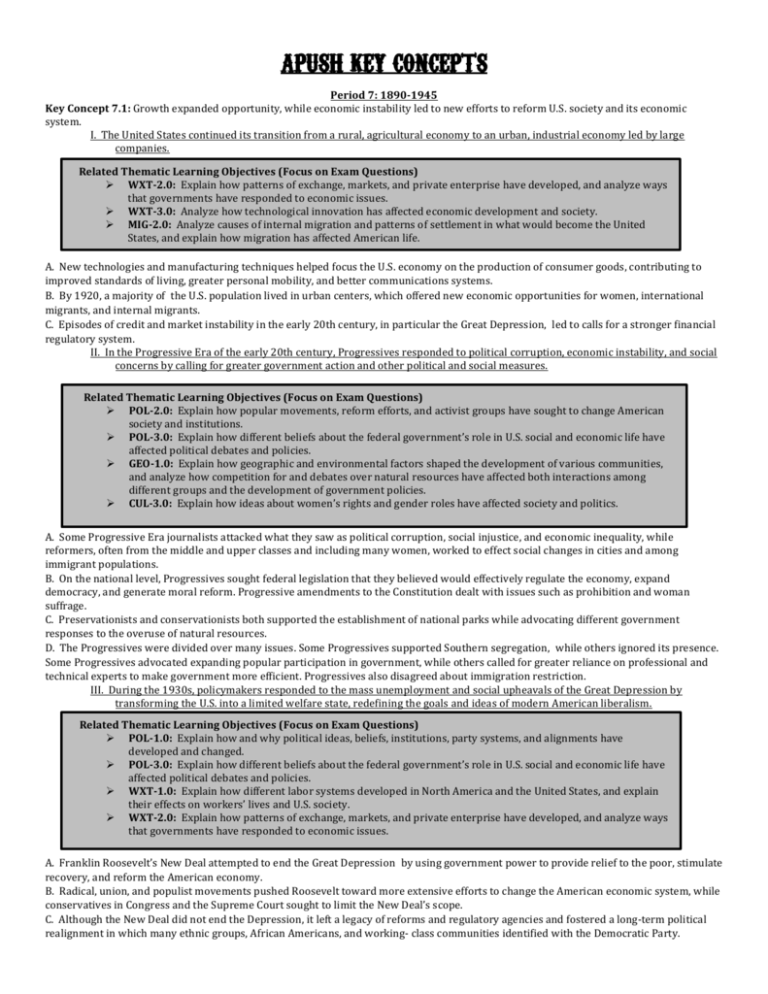
APUSH KEY CONCEPTS Period7:1890-1945 KeyConcept7.1:Growthexpandedopportunity,whileeconomicinstabilityledtoneweffortstoreformU.S.societyanditseconomic system. I.TheUnitedStatescontinueditstransitionfromarural,agriculturaleconomytoanurban,industrialeconomyledbylarge companies. RelatedThematicLearningObjectives(FocusonExamQuestions) Ø WXT-2.0:Explainhowpatternsofexchange,markets,andprivateenterprisehavedeveloped,andanalyzeways thatgovernmentshaverespondedtoeconomicissues. Ø WXT-3.0:Analyzehowtechnologicalinnovationhasaffectedeconomicdevelopmentandsociety. Ø MIG-2.0:AnalyzecausesofinternalmigrationandpatternsofsettlementinwhatwouldbecometheUnited States,andexplainhowmigrationhasaffectedAmericanlife. A.NewtechnologiesandmanufacturingtechniqueshelpedfocustheU.S.economyontheproductionofconsumergoods,contributingto improvedstandardsofliving,greaterpersonalmobility,andbettercommunicationssystems. B.By1920,amajorityof theU.S.populationlivedinurbancenters,whichofferedneweconomicopportunitiesforwomen,international migrants,andinternalmigrants. C.Episodesofcreditandmarketinstabilityintheearly20thcentury,inparticulartheGreatDepression, ledtocallsforastrongerfinancial regulatorysystem. II.IntheProgressiveEraoftheearly20thcentury,Progressivesrespondedtopoliticalcorruption,economicinstability,andsocial concernsbycallingforgreatergovernmentactionandotherpoliticalandsocialmeasures. RelatedThematicLearningObjectives(FocusonExamQuestions) Ø POL-2.0:Explainhowpopularmovements,reformefforts,andactivistgroupshavesoughttochangeAmerican societyandinstitutions. Ø POL-3.0:Explainhowdifferentbeliefsaboutthefederalgovernment’sroleinU.S.socialandeconomiclifehave affectedpoliticaldebatesandpolicies. Ø GEO-1.0:Explainhowgeographicandenvironmentalfactorsshapedthedevelopmentofvariouscommunities, andanalyzehowcompetitionforanddebatesovernaturalresourceshaveaffectedbothinteractionsamong differentgroupsandthedevelopmentofgovernmentpolicies. Ø CUL-3.0:Explainhowideasaboutwomen’srightsandgenderroleshaveaffectedsocietyandpolitics. A.SomeProgressiveErajournalistsattackedwhattheysawaspoliticalcorruption,socialinjustice,andeconomicinequality,while reformers,oftenfromthemiddleandupperclassesandincludingmanywomen,workedtoeffectsocialchangesincitiesandamong immigrantpopulations. B.Onthenationallevel,Progressivessoughtfederallegislationthattheybelievedwouldeffectivelyregulatetheeconomy,expand democracy,andgeneratemoralreform.ProgressiveamendmentstotheConstitutiondealtwithissuessuchasprohibitionandwoman suffrage. C.Preservationistsandconservationistsbothsupportedtheestablishmentofnationalparkswhileadvocatingdifferentgovernment responsestotheoveruseofnaturalresources. D.TheProgressivesweredividedovermanyissues.SomeProgressivessupportedSouthernsegregation, whileothersignoreditspresence. SomeProgressivesadvocatedexpandingpopularparticipationingovernment,whileotherscalledforgreaterrelianceonprofessionaland technicalexpertstomakegovernmentmoreefficient.Progressivesalsodisagreedaboutimmigrationrestriction. III.Duringthe1930s,policymakersrespondedtothemassunemploymentandsocialupheavalsoftheGreatDepressionby transformingtheU.S.intoalimitedwelfarestate,redefiningthegoalsandideasofmodernAmericanliberalism. RelatedThematicLearningObjectives(FocusonExamQuestions) Ø POL-1.0:Explainhowandwhypoliticalideas,beliefs,institutions,partysystems,andalignmentshave developedandchanged. Ø POL-3.0:Explainhowdifferentbeliefsaboutthefederalgovernment’sroleinU.S.socialandeconomiclifehave affectedpoliticaldebatesandpolicies. Ø WXT-1.0:ExplainhowdifferentlaborsystemsdevelopedinNorthAmericaandtheUnitedStates,andexplain theireffectsonworkers’livesandU.S.society. Ø WXT-2.0:Explainhowpatternsofexchange,markets,andprivateenterprisehavedeveloped,andanalyzeways thatgovernmentshaverespondedtoeconomicissues. A.FranklinRoosevelt’sNewDealattemptedtoendtheGreatDepression byusinggovernmentpowertoproviderelieftothepoor,stimulate recovery,andreformtheAmericaneconomy. B.Radical,union,andpopulistmovementspushedRoosevelttowardmoreextensiveeffortstochangetheAmericaneconomicsystem,while conservativesinCongressandtheSupremeCourtsoughttolimittheNewDeal’sscope. C.AlthoughtheNewDealdidnotendtheDepression,itleftalegacyofreformsandregulatoryagenciesandfosteredalong-termpolitical realignmentinwhichmanyethnicgroups,AfricanAmericans,andworking-classcommunitiesidentifiedwiththeDemocraticParty. KeyConcept7.2:Innovationsincommunicationsandtechnologycontributedtothegrowthofmassculture,whilesignificantchanges occurredininternalandinternationalmigrationpatterns. I.PopularculturegrewininfluenceinU.S.society,evenasdebatesincreasedovertheeffectsofcultureonpublicvalues,morals,and Americannationalidentity. Related Thematic Learning Objectives (Focus on Exam Questions) Ø NAT-2.0: Explain how interpretations of the Constitution and debates over rights, liberties, and definitions of citizenship have affected American values, politics, and society. Ø WXT-3.0: Analyze how technological innovation has affected economic development and society. Ø CUL-1.0: Explain how religious groups and ideas have affected American society and political life. Ø CUL-2.0: Explain how artistic, philosophical, and scientific ideas have developed and shaped society and institutions. Ø CUL-4.0: Explain how different group identities, including racial, ethnic, class, and regional identities, have emerged and changed over time. A.Newformsofmassmedia,suchasradioandcinema,contributedtothespreadofnationalcultureaswellasgreaterawareness of regionalcultures. B.Migrationgaverisetonewformsofartandliteraturethatexpressedethnicandregionalidentities,suchtheHarlemRenaissance movement. C.OfficialrestrictionsonfreedomofspeechgrewduringWorldWarI,asincreasedanxietyaboutradicalismledtoaRedScareandattacks onlaboractivismandimmigrantculture. D.Inthe1920s,culturalandpoliticalcontroversiesemergedasAmericansdebatedgenderroles,modernism,science,religion,andissues relatedtoraceandimmigration. II.Economicpressures,globalevents,andpoliticaldevelopmentscausedsharpvariationsinthenumbers,sources,andexperiencesof bothinternationalandinternalmigrants. RelatedThematicLearningObjectives(FocusonExamQuestions) Ø CUL-4.0:Explainhowdifferentgroupidentities,includingracial,ethnic,class,andregionalidentities,have emergedandchangedovertime. Ø MIG-1.0:ExplainthecausesofmigrationtocolonialNorthAmericaand,later,theUnitedStates,andanalyze immigration’seffectsonU.S.society. Ø MIG-2.0:AnalyzecausesofinternalmigrationandpatternsofsettlementinwhatwouldbecometheUnited States,andexplainhowmigrationhasaffectedAmericanlife. A.ImmigrationfromEuropereacheditspeakinthe yearsbeforeWorldWarI.DuringandafterWorldWarI,nativistcampaignsagainst someethnicgroupsledtothepassageofquotasthatrestrictedimmigration,particularlyfromsouthernandeasternEurope,andincreased barrierstoAsianimmigration. B.TheincreaseddemandforwarproductionandlaborduringWorldWarIandWorldWarIIandtheeconomicdifficultiesofthe1930sled manyAmericanstomigratetourbancentersinsearch ofeconomicopportunities. C.InaGreatMigrationduringandafterWorldWarI,AfricanAmericansescapingsegregation,racialviolence,andlimitedeconomic opportunityintheSouthmovedtotheNorthandWest,wheretheyfoundnewopportunitiesbutstillencountereddiscrimination. D.MigrationtotheUnitedStatesfromMexicoandelsewhereintheWesternHemisphereincreased, inspiteofcontradictorygovernment policiestowardMexicanimmigration. KeyConcept7.3:ParticipationinaseriesofglobalconflictspropelledtheUnitedStatesintoapositionofinternationalpowerwhile renewingdomesticdebatesoverthenation’sproperroleintheworld. I.Inthelate19thcenturyandearly20thcentury,newU.S.territorialambitionsandacquisitionsintheWesternHemisphereandthe PacificaccompaniedheightenedpublicdebatesoverAmerica’sroleintheworld. RelatedThematicLearningObjectives(FocusonExamQuestions) Ø NAT-3.0:AnalyzehowideasaboutnationalidentitychangedinresponsetoU.S.involvementininternational conflictsandthegrowthoftheUnitedStates. Ø WOR-2.0:Analyzethereasonsfor,andresultsof,U.S.diplomatic,economic,andmilitaryinitiativesin NorthAmericaandoverseas. A.Imperialistscitedeconomicopportunities,racialtheories,competitionwithEuropeanempires,andtheperceptioninthe1890sthatthe Westernfrontierwas“closed”toarguethatAmericansweredestinedtoexpandtheircultureandinstitutionstopeoplesaroundtheglobe. B.Anti-imperialistscitedprinciplesofself-determinationandinvokedbothracialtheoriesandtheU.S.foreignpolicytraditionof isolationismtoarguethattheU.S.shouldnotextenditsterritoryoverseas. C.TheAmericanvictoryin theSpanish–AmericanWarledtotheU.S.acquisitionofislandterritoriesintheCaribbeanandthePacific,an increaseininvolvementinAsia,andthesuppressionofanationalistmovementinthePhilippines. II.WorldWarIanditsaftermathintensifiedongoingdebatesaboutthenation’sroleintheworldandhowbesttoachievenational securityandpursueAmericaninterests. RelatedThematicLearningObjectives(FocusonExamQuestions) Ø NAT-1.0:Explainhowideasaboutdemocracy,freedom,andindividualismfoundexpressioninthe developmentofculturalvalues,politicalinstitutions,andAmericanidentity. Ø NAT-3.0:AnalyzehowideasaboutnationalidentitychangedinresponsetoU.S.involvementin internationalconflictsandthegrowthoftheUnitedStates. Ø WOR-2.0:Analyzethereasonsfor,andresultsof,U.S.diplomatic,economic,andmilitaryinitiativesin NorthAmericaandoverseas. A.AfterinitialneutralityinWorldWarI,thenationenteredtheconflict,departingfromtheU.S.foreignpolicytraditionofnoninvolvement inEuropeanaffairs,inresponsetoWoodrowWilson’scallforthedefenseofhumanitariananddemocraticprinciples. B.AlthoughtheAmericanExpeditionaryForcesplayed arelativelylimitedroleincombat,theU.S.’sentryhelpedtotipthebalanceofthe conflictinfavoroftheAllies. C.DespiteWilson’sdeepinvolvementinpostwarnegotiations,theU.S.SenaterefusedtoratifytheTreatyofVersaillesorjointheLeagueof Nations. D.IntheyearsfollowingWorldWarI,theUnitedStatespursuedaunilateralforeignpolicythatusedinternationalinvestment,peace treaties,andselectmilitaryinterventiontopromoteavisionofinternationalorder,evenwhilemaintainingU.S.isolationism. E.Inthe1930s,whilemanyAmericanswereconcernedabouttheriseoffascism andtotalitarianism,mostopposedtakingmilitaryaction againsttheaggressionof NaziGermanyandJapanuntiltheJapaneseattackonPearlHarbordrewtheUnitedStatesintoWorldWarII. III.U.S.participationinWorldWarIItransformedAmericansociety,whilethevictoryoftheUnitedStatesanditsalliesovertheAxis powersvaultedtheU.S.intoapositionofglobal,political,andmilitaryleadership. RelatedThematicLearningObjectives(FocusonExamQuestions) Ø NAT-3.0:AnalyzehowideasaboutnationalidentitychangedinresponsetoU.S.involvementin internationalconflictsandthegrowthoftheUnitedStates. Ø NAT-4.0:Analyzerelationshipsamongdifferentregional,social,ethnic,andracialgroups,andexplain howthesegroups’experienceshaverelatedtoU.S.nationalidentity. Ø CUL-3.0:Explainhowideasaboutwomen’srightsandgenderroleshaveaffectedsocietyandpolitics. Ø WOR-2.0:Analyzethereasonsfor,andresultsof,U.S.diplomatic,economic,andmilitaryinitiativesin NorthAmericaandoverseas. A.Americansviewedthewarasafightforthesurvivaloffreedomanddemocracyagainstfascist andmilitaristideologies.Thisperspective waslaterreinforcedbyrevelationsaboutJapanesewartimeatrocities,Naziconcentrationcamps,andtheHolocaust. B.Themassmobilizationof AmericansocietyhelpedendtheGreatDepression,andthecountry’sstrongindustrialbaseplayedapivotal roleinwinningthewarbyequippingandprovisioningalliesandmillionsofU.S.troops. C.Mobilizationandmilitaryserviceprovidedopportunitiesforwomenandminoritiestoimprovetheirsocioeconomicpositionsforthe war’sduration,whilealsoleadingtodebatesoverracialsegregation.Wartimeexperiencesalsogeneratedchallengestocivilliberties,such astheinternmentofJapaneseAmericans. D.TheUnitedStatesanditsalliesachievedmilitaryvictorythroughAlliedcooperation,technologicalandscientificadvances,the contributionsofservicemenandwomen,andcampaignssuchasPacific“island-hopping”andtheD-Dayinvasion.Theuseofatomicbombs hastenedtheendofthewarandsparkeddebatesaboutthemoralityofusingatomicweapons. E.Thewar-ravagedconditionofAsiaandEurope,andthedominantU.S.roleintheAlliedvictory andpostwarpeacesettlements,allowed theUnitedStatestoemergefromthewarasthemostpowerfulnationonearth. Constructed Response Questions 1. To what extent were Progressives able to reform social, political, and economic problems of the Gilded Age? 2. How did US involvement in World War I effect the American home front? 3. How were traditionalist views of religion, gender, and race challenged during the 1920s? 4. How did FDR’s New Deal attempt address the issues that caused the Great Depression? 5. In what ways was American society transformed by US involvement in World War II?
